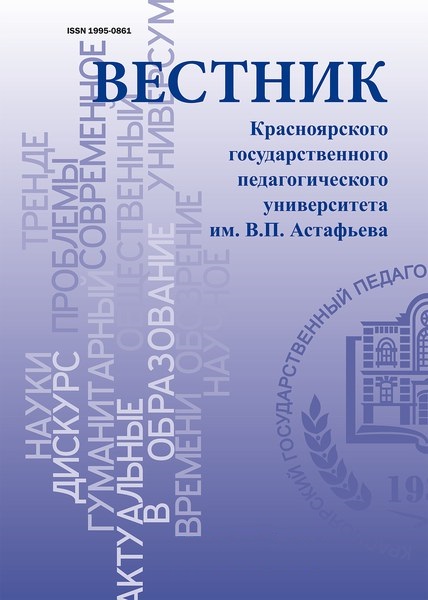РАЗВИТИЕ ОБРАЗОВ «Я» И «ДРУГОЙ» В РАННЕМ ДЕТСКОМ ВОЗРАСТЕ: ГЕНДЕРНЫЙ АСПЕКТ
Аннотация
Аннотация
Проблема и цель. Развитие социального созна-
ния как целостной системы социальных представле-
ний, особенно в возрастном и гендерном аспектах, яв-
ляется чрезвычайно актуальной областью психологи-
ческих исследований, значимых для развития различ-
ных отраслей психологии: общепсихологического зна-
ния, социальной психологии, когнитивной психоло-
гии и других. Авторы данной статьи фокусируют вни-
мание на проблеме личностного развития детей ран-
него возраста, составляющими которой являются про-
цесс и механизмы формирования образов «я» и «дру-
гой», полагая, что существует гендерно обусловленная
разница в их структуре и характеристиках, начиная с
самого раннего онтогенеза. Во-первых, направлен-
ное на детей поведение взрослых имеет особенности
с точки зрения формирования гендера ребенка начи-
ная с младенческого возраста, что в раннем детстве
приводит к гендерной самоидентификации ребенка.
Литература
2. Дусказиева Ж.Г. Особенности материнского отношения к соматически ослабленным мальчикам // Вестник КГПУ им. В.П. Астафьева. 2015. № 1. С. 145–148.
3. Каган В.Е. Когнитивные и эмоциональные аспекты гендерных установок у детей 3–7 лет // Вопросы психологии. 2000. № 2. С. 65–69.
4. Кайл Р. Детская психология: Тайны психики ребенка. СПб.: Прайм-Еврознак, 2000. 416 с.
5. Коатс Дж. Женщины, мужчины и язык // Гендер и язык / под ред. А.В. Кириллиной. М., 2005. С. 33–223.
6. Маланчук И.Г., Залевская А.Г. Гендерные особенности социального сознания детей раннего возраста (на материале анализа речи) // Вестник КГПУ им. В.П. Астафьева. 2018. № 3 (45). С. 113–125. DOI: https://doi.org/10.25146/1995-0861-2018-45-3-80.
7. Маланчук И.Г. Коммуникативные и коммуникативно-связанные потребности как фактор продуцирования речи (на материале детской речи) // Вестник КГПУ им. В.П. Астафьева. 2007. № 1. С. 82–89.
8. Маланчук И.Г. Речь как психический процесс: монография. Красноярск, 2009. 264 с.
9. Маланчук И.Г. Социальное сознание и речевое поведение в дошкольном возрасте: учеб. пособие / Краснояр. гос. пед. ун-т им. В.П. Астафьева. Красноярск, 2014. 236 c.
10. Осорина М.В. Секретный мир детей в пространстве мира взрослых. СПб.: Питер, 2015. 304 с.
11. Перегудина В.А. Особенности гендерной социализации в детских возрастах // Известия Тульского государственного университета. Гуманитарные науки. 2008. № 1. С. 177–187.
12. Репина Т.А. Проблема поло-ролевой социализации детей. М.: МПСИ, Воронеж: МОДЭК, 2004. 288 с.
13. Семенова Л.Э. Гендерный анализ стратегии и тактики притязаний у детей старшего дошкольного возраста // Вопросы психологии. 2002. № 6. С. 23–31.
14. Bigler R., Hayes A.R., Hamilton V. The role of schools in the early socialization of gender differences. Martin CL, topic ed. // Tremblay R.E., Boivin M., Peters R. De V., eds. Encyclopedia on Early Childhood Development [online]. Montreal, Quebec: Centre of Excellence for Early Childhood Development and Strategic Knowledge Cluster on Early Child Development. 2013. P. 1–5. Available. URL: http://www.child-encyclopedia.com/documents/Bigler-Hayes-HamiltonANGxp1.pdf
15. Bigler R.S. The role of classification skill in moderating environmental influences on children»s gender stereotyping: A study of the functional use of gender in the classroom // Child Development. 1995. Vol. 66. P. 1072–1087.
16. Boisferon A.H., Dupierrix E., Quinn P.C., Lœvenbruck H., Lewkowicz D.J., Lee K., Pascalis O. Perception of multisensory gender coherence in 6- and 9-month-old infants // Infancy. 2015. Vol. 20 (6). P. 661–674.
17. Bornstein M., Giusti Z., Leach D.B., Venuti P. Maternal reports of adaptive behaviours in young children: urban–rural and gender comparisons in Italy and United States // Infant and Child Development. 2005. Vol. 14 (4). P. 403–424. DOI: 10.1002/icd.414
18. Escudero P., Robbins R., Johnson S. Sex-related preferences for real and doll faces versus real and toy objects in young infants and adults. Journal of Experimental Child Psychology. 2013. Vol. 116 (2). P. 367–379.
19. Gianesini G. Gender Identity. In: Encyclopedia of Family Studies. John Wiley & Sons, 2016. P. 928–933. DOI: htpps://doi.org/10.1002/9781119085621.wbefs465
20. Greif E.V. Sex differences in parent-child conversation. The voices and words of women and men. Pergamon Press, Oxford. 1980. P. 253–258.
21. Karniol R. Israeli kindergarten children,s gender constancy for others, counter-stereotypic toy play and appearance: the role of sibling gender and relative age // Infant and Child Development. 2009. Vol. 18 (1). P. 73–94. DOI: htpps://doi.org/10.1002/icd.592
22. Kawai E., Takagai Sh., Takei N., Itoh H., Kanayama N., Tsuchiya K.J. Maternal postpartum depressive symptoms predict delay in non-verbal communication in 14-month-old infants. Infant Behavior and Development. 2017. Vol. 46. P. 33–45.
23. Langlois J., Downs A. Mothers, fathers, and peers as socialization agents of sex-typed play behaviors in young children // Child development. 1980. Vol. 51. P. 1217–1247.
24. LeBarton E.S., Iverson J.M. Associations between gross motor and communicative development in at-risk infants // Infant Behavior and Development. 2016. Vol. 44. P. 59–67.
25. Lowe J.R., Coulombe P., Moss N.C., Rieger R.E., Aragón C., MacLean P.C., Caprihan A., Phillips J.P., Handal A.J. Maternal touch and infant affect in the Still Face Paradigm: A cross-cultural examination // Infant Behavior and Development. 2016. Vol. 44. P. 110–120.
26. Lytton H., Romney D. Parent»s differential socialization of boys and girls: A meta-analysis // Psychological Bulletin. 1991, Vol. 109 (2). P. 267–296.
27. McHale S., Huston T. Men and women as parents: Sex role orientations, employment, and parental roles with infants // Child Development. 1984. Vol. 55. P. 1349–1361.
28. Miller D.I, Nolla K.M., Eagly A.H., Uttal D.H. The development of children,s gender-science stereotypes: Meta-analysis of 5 decades of U.S. draw-a-scientist studies // Child Development. 2018. (in press). P. 1–13. DOI: https://doi.org/10.1111/cdev.13039
29. Qu J., Leerkes E.M., King E.K. Preschoolers» distress and regulatory behaviors vary as a function of infant–mother attachment security // Infant Behavior and Development. 2016. Vol. 44. P. 144–147.
30. Plant E.A., Hide J.Sh., Keltner D., Devine P.G. The gender stereotyping of emotions // Psychology of Woman Quarterly. 2000. Vol. 24(1). P. 80–92.
31. Roger K.M., Rinaldi Ch.M., Howe N. Mothers, and Fathers, internal state language with their young children: An examination of gender differences during an emotions task // Infant and Child Development. 2012. Vol. 21 (6). P. 646–666. DOI: htpps://doi.org/10.1002/icd.1762
32. Schoppe-Sullivan S.J., Diener M.L., Mangelsdorf S.C., Brown G.L., McHale J.L., Frosch C.A. Attachment and sensitivity in family context: the roles of parent and infant gender // Infant and Child Development. 2006. Vol. 15 (4) P. 367–385. DOI: htpps://doi.org/10.1002/icd.449
33. Scola C., Holvoet C., Arciszewski T., Picard D. Further evidence for infants, preference for prosocial over antisocial behaviors // Infancy. 2015. Vol. 20. P. 684–692.
34. Serbin L.A., Poulin-Dubois D., Eichstedt J.A., Infants, responses to gender-inconsistent events // Infancy. 2002. Vol. 3(4). P. 531–542. DOI: htpps://doi.org/10.1207/s15327078in0304_07
35. Todd B.K., Barry J.A., Thommessen S.A.O. Preferences for «gender-typed» toys in boys and girls aged 9 to 32 months. Infant and Child Development. 2016. Vol. 26 (3). Published online in Wiley Online Library (wileyonlinelibrary.com). DOI: htpps://doi.org/10.1002/icd.1986
36. Valla L., Wentzel-Larsen T., Smith L., Birkeland M., Slinning K. Association between maternal postnatal depressive symptoms and infants, communication skills: A longitudinal study // Infant Behavior and Development, 2016. Vol. 45. P. 83–90.









